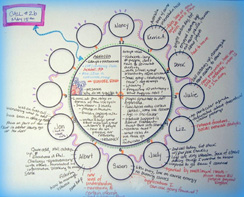Difference between revisions of "Teleconference Clock Method"
From Learning and training wiki
Marco.perone (Talk | contribs) |
Marco.perone (Talk | contribs) |
||
| Line 6: | Line 6: | ||
=='''Preparing a Teleconference Clock'''== | =='''Preparing a Teleconference Clock'''== | ||
| − | + | *Have an agenda that includes conference goals and participants’ expectations. Don’t forget to consider their time zones when scheduling. | |
| − | + | *Consider the impact of comments volume (based on the number of participants) with the available time. | |
| − | + | *Send all participants the dial-in number and pass-codes if needed. With international groups, be clear if the number is cost-free. | |
| − | + | *Distribute supporting documents or files before the beginning of the conference call. | |
| − | + | *Take care in advance of the call controls. If the leader controls the start/stop of the call and may have to leave early, have a second person with leader privileges in order to avoid call interruptions. | |
| − | + | *Greet everyone once online and use the “clock" method for the introduction of each participant. | |
| − | + | ||
=='''Step by Step'''== | =='''Step by Step'''== | ||
Revision as of 15:30, 9 December 2009
| Method designed to assist moderators to regulate and facilitate the interaction between participants during conference calls. The Teleconference Clock creates a speaking sequence for introducing each participant: people are given a place on the clock as a mechanism to ensure that everyone has a chance to speak. The “clock” is used to encourage participation on conference calls or structured online chats involving more than four people. [1] |
Preparing a Teleconference Clock
Step by Step
General Call Etiquette
Job Aid |
References
- ↑ [1] (26 November 2009),[2] (26 November 2009), [3] (26 November 2009), [<divxmlns:cc="http://creativecommons.org/ns#"about="http://www.flickr.com/photos/choconancy/2333690088/"><arel="cc:attributionURL"href="http://www.flickr.com/photos/choconancy/">http://www.flickr.com/photos/choconancy/</a> / <a rel="license"href="http://creativecommons.org/licenses/by-nc-sa/2.0/">CC BY-NC-SA 2.0</a></div>] (30 November 2009)
